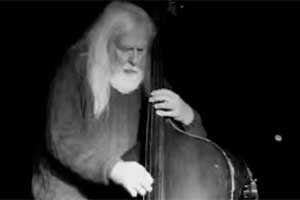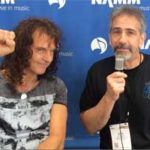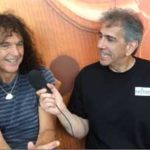Bass legend recounts his history-making role in the big band era, plus the gigs with Coleman Hawkins, Roy Eldridge and Buddy Rich
Exclusive interview with FBPO’s Jon Liebman
July 19, 2010
As a teenager, Peter Ind began playing dance halls in London, first as a pianist, then as a double bass player. Soon afterward, he began performing on the Queen Mary for trips to New York. Settling into the New York jazz scene, Peter found himself playing with jazz legends Coleman Hawkins, Roy Eldridge, Buddy Rich and Warne Marsh, as well as performing and studying with pianist Lennie Tristano.
Ind spent time in Big Sur, California, performing, painting and writing about energy and cosmic metabolism. After returning to the U.K. in the 1960s, Peter performed with European jazz luminaries Martin Taylor, Louis Stewart and Stephane Grapelli.
Peter launched his own record label, Wave, and had a successful run as the owner and manager of two jazz clubs in the London area, Bass Clef and Tenor Clef. Peter continues to write, perform and teach, mostly in the U.K. and France and is still releasing CDs on his Wave label.
FBPO: Tell me about your musical upbringing. How did you end up as a bass player?
PI: My parents were amateur musicians and encouraged my sister and me to study music. I taught myself piano and played violin in the school orchestra. No one in my family was into jazz. I grew to like it after hearing bands like Glenn Miller on the radio and listening to recordings of Louis Armstrong.
In 1942, when I was 14, I started playing piano at dances. You have to remember that this was World War II and there was high demand for dance bands for servicemen and women, so I was kept plenty busy. At 16, I attended Trinity College part-time to study piano harmony, but could only afford to go for a short time. I started playing bass around the same time, self-taught. I realized one day when I was playing the violin that my fly was open and the bass seemed like a good way to avoid further embarrassment! Actually, I do love the bass! In fact, I had some lessons with James Merrett, the foremost classical bass player at the time. Interestingly, his son turned out to be one of Dave Holland’s teachers.
FBPO: How did you come to play on the Queen Mary trips to New York? What was that like?
PI: In 1949, I signed a six-month contract to play on the Queen Mary. They had bands playing in the different cabin classes. I had never even left the U.K. before and the experience of New York and the jazz was overwhelming. I heard Lennie Tristano’s group at the Orchid Room on 52nd Street. When I learned that Lennie was also a teacher, I began studying with him each time I came over working on the Q.M.
FBPO: Why did you end up settling in New York? What were your musical aspirations at the time?
PI: After taking a lesson with Lennie during one of my early trips, he asked me if I would play a set with his band at Birdland. It was the excitement of playing with his band that made me decide that New York was where I wanted to be. I continued working on the Q.M. and in April 1951 I moved to New York after having obtained an immigration visa. I continued my studies with Lennie and, in November 1951, I recorded some tracks with him and drummer Roy Haynes. I didn’t stop to consider where I was headed, musically. I just loved the jazz, the excitement of New York life and the relief of being able to leave the austerity of post-war Britain.
FBPO: You were right there in the midst of what could be called one of the most significant breakthroughs in 20th Century music, when real jazz was the music of the day. Did you realize you were a part of history when you were playing with Coleman Hawkins, Roy Eldridge, Buddy Rich and other jazz legends, or did if feel like you were just playing gigs with some really great players?
PI: I think to some degree I realized the significance of the jazz scene as it was, though I thought it would go on forever. I didn’t stop to reflect that maybe it was just a moment in history or that other forms of music would take over.
Before I went to live in New York, Ray Brown and Charlie Mingus were definitely big influences on my playing. One of my early memories was going to see Ray Brown play on 52nd Street. I think it was with John Lewis. To anyone who saw Ray perform, it was the strength of his playing that was so endearing.
But you have to remember that in the early ’50s a lot of the jazz musicians were young and most of them could hardly be considered icons. I played with a very young Miles Davis, who, at the time, was very different from his later persona. He was shy, but had a recognizable sound, even then. I lived in a rooming house. Blossom Dearie lived there too, in bobby sox! I knew Charlie Mingus and Celia. I was living in the same apartment building as Mingus. He would come over to talk about bass playing. Percy Heath used to come over for lessons and ask about my techniques. You have to remember that I had had classical training, which not many jazz musicians had had. In fact, I first met Mingus by accident in 1949. I was playing bass at Noah Wulfe’s bass shop, trying out part of a Bach two-part invention, when this voice boomed out “Who is that?!” Mingus once said to me, “You were the first to play that high shit on the bass.” Acknowledgement indeed!
The jazz scene was not so large and it was informal. I was playing with Jutta Hipp, a very talented pianist from Germany in the mid 1950s at the Hickory House and various musicians would stop by and sit in. One memorable night, Duke Ellington sat in. It was like that in New York in the ’50s.
I remember Arvel Shaw playing with Louis Armstrong. I was playing with Lee’s band, opposite Louis’ band in East St West in 1955. Arvel was a large man and the bass looked like a cello in his hands!
Another memory was playing in the Café Bohemia with Oscar Pettiford. Oscar was playing cello at that time and we played together as a duo. It is unusual for two bass players ever to play together. Much later, in the 1990s, Rufus (Reid) and I so enjoyed making our duo CD and subsequent DVD, Alone Together. [Editor’s note: See FBPO’s interview with Rufus Reid.]
FBPO: I’ve always associated Lee Konitz, Warne Marsh, Billy Bauer and Lennie Tristano with the West Coast style of jazz in the ’50s, part of the whole “Birth of the Cool” era. Weren’t you still in New York when you hooked up with them?
PI: The word “cool” was originally used to describe Lennie Tristano’s influence. Of course, Miles’ album, Birth of the Cool, was similarly associated. Lennie never went to the West Coast. The only one of Lennie’s group who was from the West Coast was Warne Marsh, whose father, Oliver Marsh, was a noted Hollywood cameraman. Warne was living in New York through the early 1950s, as were the other musicians associated with Lennie.
In 1956, Warne returned to California and worked with his own band, which included Ted Brown, Jeff Morton, Ronnie Ball and Ben Tucker. Jeff Morton and I all went to L.A. in December of 1954 as part of the Lee Konitz group and we stayed there for a couple of months. We returned to New York in early ’55 and were based there all through the rest of the 1950s, though we frequently did out of town gigs, too. Playing with Buddy Rich in Miami was one example that stands out. I also did a whole host of other out of town gigs with Roy Eldridge, Coleman Hawkins, Paul Bley and many others.
In 1957, I set up my own recording studio, having already begun recording activities in a semi-professional manner in 1954. I had a loft in Astoria, Long Island. In 1960, I moved to a downtown Manhattan loft, where I made many recordings, not only with Lee, but with many others, as well. Booker Erwin, Al Cohn and Zoot Sims, Gerry Mulligan and Booker Little were some of the jazz artists who recorded in my East 2nd Street loft. It was in this loft that I established the Wave label.
FBPO: What took you back to California?
PI: In December 1961, I gave up my loft, sold my Steinway piano and Ampex recording equipment and returned to the U.K., where I was reunited with the lady who subsequently became my first wife. When I had gone back to New York in January 1963, I found the jazz scene much changed. Gigs were in short supply and many of the musicians who had been successful were now struggling.
In May of that year, our family, which now included our baby daughter, decided to relocate to Big Sur, where we stayed for three years. In due course, both Lee and Warne moved to the area and lived in Monterey County. Guitarist Al Shackman also moved to Big Sur and, for some time, we had some great reunion gigs.
FBPO: So what made you decide to return and settle in the U.K. after so many years? What happened once you got there?
The Big Sur adventure was great in many ways, but it became very difficult to earn a living. I played at many venues up and down the coast and recorded what I believe to have been the very first solo bass recital at Hertz Hall at the University of California Berkeley campus. Some of this recital is available on Wave CD 4, 60 Years With My Bass. My wife, like many American women, loved Europe, so we decided to return to the U.K., where I was still remembered as a jazz musician. In retrospect, it worked out okay, though there was not much security in playing jazz. I developed a teaching practice, played quite extensively with various symphony orchestras and became part of the session recording scene. In fact I heard on TV very recently the Bach music accompanying the Hamlet cigar ad that I recorded as a session musician.
By the mid-1970s, I reunited with Lee and Warne again and with drummer Al Levitt and we played some extensive tours in Europe and the U.K. It was then that I found enough money to put a down payment on a house in Twickenham that, in due course, become the nucleus of a new studio for my Wave label and other recordings. This became so successful that I eventually relocated the Wave studios premises to Hoxton Square in London. At the time, it was a very run-down area. We were the first new venue to become established there, starting the renovation of Hoxton Square. The building was incredibly run-down too and I was heavily involved in the renovation work. This was in late 1981.
FBPO: Talk a little about the clubs you’ve owned and managed.
PI: In 1984, I opened the Bass Clef club in the same premises, adding the adjoining building to make a good-sized venue. Ronnie Scott’s band opened the club, which I ran for ten years. It was extremely successful. In addition to jazz, we hosted Latin and African nights. In 1990, we opened a second club in the same premises, the Tenor Clef. It was an amazing time, really. We had all sorts of musicians like Dudu Pukwana, Oscar D’León, Abdul Tee Jay, Kenny Barron, Roberto Pla, Bertice Redding, Ian Carr and the Calderazzo brothers. Most of the younger generations of jazz musicians played there too. The list is so large: Nigel Kennedy, Ian Shaw, Claire Martin, Iain Ballamy, Lianne Carroll, Tina May, Julian Joseph, the Arguelles brothers, Django Bates and lots of others. Some of the bass players included Alec Dankworth, Mick Hutton and Gary Crosby. Courtney Pine had his first professional gig there. Despite the popularity of the two clubs, the recession of the early nineties plus the high interest rates eventually decided the club’s fate and early in 1994 receivers were called in and the clubs folded. It was a difficult time. It took me years to pay off debts!
FBPO: Tell me about your recordings?
PI: Gosh, there are a lot! While in New York I played on about sixty recordings, but all as a sideman. I was doing stuff for Atlantic, Storyville, Columbia and EMARCY. Most notably, I recorded two tracks with Lennie Tristano that were the very first overdubbed backing tracks, a totally new concept at that time.
In 1960 in New York, I formed Wave Records and launched a long succession of recordings. I recorded the Looking Out album, now available on Wave as a CD. It was Sheila Jordan’s first recording and it included Sal Mosca, Ronnie Ball, Bill Puma and Al Shackman.
When I moved back to the U.K. in 1966, I began to record a series of LPs as leader with my own band, the Peter Ind Sextet, as well as duos with a young Martin Taylor. A lot of my work involved collaborative duos and trios, like the CD and subsequent DVD I made with Rufus Reid that I mentioned earlier. Rufus is a great friend and wonderful bass player.
After the club closed I set up a band in its memory, Bass Clef International, with a group of some great musicians in the U.K. and Rod Youngs, originally from the U.S., who was the drummer. Rod recently played a series of concerts in London and France with Lee Konitz and me – reunion gigs after 60 years! I am currently finalizing a CD of the music from those dates.
I suppose my most recent CD would be of particular interest to bass players, Peter Ind – 60 years with my bass – well almost! On this CD, I am playing solos, but also tunes with Tony Barnard, with whom I’ve recorded a number of CDs, and Matt Wates. I am also re-releasing Time for Improvisation on CD, mostly due to requests. It’s a collection of solo bass rhythm tracks for musicians to play along with. Wave is still operating. We have 24 CDs in the catalogue.
FBPO: What else has been keeping you busy?
PI:What hasn’t been keeping me busy?! I have another career as a painter and I exhibit from time to time in various countries. I had a special 80th birthday celebration in 2008, for which I had a special exhibition in London. This past June, I exhibited in France. Next year, Barcelona.
After the club went down, I turned my passion for blue and white Chinese porcelain into a skill and trained in ceramic restoration.
I continually write. In fact, in 1964 I wrote a first manuscript in Big Sur about Wilhelm Reich’s concepts and discussing life energy. The work is entitled Cosmic Metabolism and Vortical Accretion. I gave a lecture on it at Esalen. In 2005 I wrote a book about Lennie Tristano, called Jazz Visions – Lennie Tristano and His Legacy, published by Equinox. Last year I published another book, The Environment and Cosmic Metabolism – Looking at the Stars and Thinking About the Earth. In fact, the director of London’s Cockpit Theatre read the book and has asked me to give an evening performance. It’s scheduled for November 3, 2010.
I enjoy performances of very different kinds. I was recently in Amman, Jordan, and was invited to play in a Tchaikovsky concert with the Jordan National Symphony orchestra. I also got to participate in a really enjoyable evening performance of music, prose and poetry with Nabil Sawalha, entitled Maverick Thoughts of East Meets West, including duos with a very creative Middle East oud player, named Hummam Eid. We intend to make a CD together. I have always had a very special love for Middle Eastern music after playing with the Norikes, an Armenian band that was playing jazz in New York. I had my only hit record with them, Take me to the Casbah! One of my favorite pieces to play is an improvisation on an Armenian tune, inspired by that group. In fact, I played it at the international bass players concert at the Théatre du Châtelet in Paris. That was where I first met François Rabbath, a really wonderful man and a very great bass player. I dedicated the tune to him. His mother was Armenian.
I continue to teach, still influenced by the excellent method of Lennie Tristano. I’ve also given some master classes and was recently asked to be a patron of the Yamaha Jazz Experience, which supports and encourages schoolchildren to play jazz. I was one of the judges at the Cheltenham Jazz Festival in May. I was really impressed by the incredible performances from kids aged 11 to 19. It really gave me great hope for the future of jazz, especially since most of the older bands had a double bass player.
I should also mention that I have completed a draft of a book with my wife Sue – who had to live through all the lows as well as the highs! – about the Bass Clef club and its contribution to the U.K. jazz scene. We have submitted it to a publisher – fingers crossed! Periodically I still play gigs too.
FBPO: What would you like to do that you haven’t already accomplished?
PI: Really, Jon, I so enjoy all that I do. I am so enjoying life. At 81 (82 on the 20th of July), I just thoroughly enjoy doing what I do. I am totally committed to live improvisation, so more of the same!
If you pressed me, specifically, I would like to play more with younger jazz musicians. I have so enjoyed playing with younger generations of jazz musicians in recent years, in the U.K. and France. We now live for part of the year in Auvers sur Oise, north of Paris, where Van Gogh painted and ultimately died. It’s a lively center of painting and jazz. I’d like to do more playing and master classes.
I am enjoying seeing what new generations of jazz musicians, especially bass players, are doing with jazz. I recently played with some of the next generation of jazz musicians in the U.K., including pianists Gwilym Simcock and Kit Downes. This month, I will be recording a new CD with Ian Shaw and a young guitarist named Dave Preston. They all have great energy, sometimes raw, but enormous commitment and life in their music and they bring a freshness to jazz improvisation. I love that!
I only wish that organizations like the BBC would play more jazz. What about a program on jazz bass players? It’s a thought!
Long live jazz Improvisation!







